
WWW.ANDRERIEUMOVIES.COM
Museum of Natural History
Mosasaurus exhibitions

Imagine….. 60 - 70 millions years ago….. the Cretaceous period.
The Netherlands and Maastricht were on the bottom of the sea.
Huge monsters, named Mosasaurus, were swimming in the sea.......
Newspaper article, April 2015:
On April 18th 2015 the remains of another huge prehistoric Mosasaurus (Meuse Lizard) were found in the
ENCI (cement factory) chalk quarry in the St. Pietersberg, Maastricht,
the Netherlands, by a 14 years old boy named Lars and his father.
Since 1774 this is the sixth Mosasaurus found in the hill (close by Andre's castle!!).
Three of the relics (and we guess the fourth will be added soon) can be seen in the Museum of Natural
History in Maastricht. Address: De Bosquetplein 7.
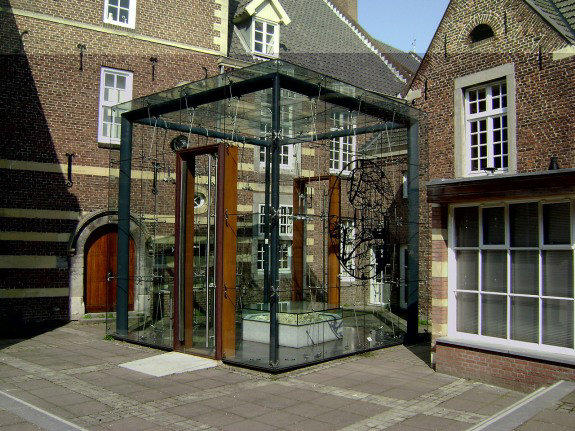
From Wikipedia: Mosasaurus is a genus of Mosasaur, carnivorous, aquatic lizard, somewhat resembling
flippered crocodiles with elongated heavy jaws. The genus existed during the Maastrichtian age of the
Cretaceous period (Mesozoic era), around 60-70 million years ago in the area of modern Western Europe
and North America. The name means "Meuse lizard", since the first specimen was found near the Meuse
River (Latin Mosa + Greek sauros lizard). As with most Mosasaurs, their legs and feet are modified into
hydrofoil-like flippers, with the front limbs being larger than the rear limbs. Mosasaurus reached lengths of
about 13 - 18 meters (59 ft), somewhat longer than its American relatives Tylosaurus and Hainosaurus.
However, Mosasaurus was more robust than the somewhat smaller sized Tylosaurine Mosasaurs.
Mosasaurus was among the last mosasaur genera, and among the largest. The skull was more robustly
built than in other Mosasaurs, as the mandibles articulated very tightly with the skull. It had a deep, barrel-
shaped body, and with its fairly large eyes, poor binocular vision, and poorly developed olfactory bulbs,
experts believe that Mosasaurus lived near the ocean surface, where it preyed on fish, turtles, ammonites,
and possibly smaller Mosasaurs. The animal remained near the surface and although it was able to dive, it
evidentially did not venture into deeper waters.
The skull of Mosasaurus is tapered off into a short, conical process, and the jaws were armed with
massive, sharp, conical teeth. Their paddle-like limbs had five digits in the front and four in the back. The
trunk terminated in a strong tail which, together with serpentine undulation of the whole body, contributed
far more to the animal's locomotion than did the limbs.

1764: The first Mosasaurus, genus of mosasaur to be named. The first remains found by scientists were a
fragmentary skull from a chalk quarry in the St. Pietersberg, a hill near Maastricht, the Netherlands, found
in 1764 and collected by lieutenant Jean Baptiste Drouin in 1766. It was procured for the Teylers Museum
at Haarlem in 1784. The first director of the museum published its description only in 1790. He considered
it to be a species of "big breathing fish" (Pisces cetacei, in other words: a whale). It is still part of the
collection as TM 7424.
At some time between 1770 and 1774 a second partial skull was discovered and unearthed. It was found
in the grounds owned by canon Theodorus Joannes Godding, who displayed it in his country house on the
slope of the St. Pietersberg hill. A local retired German/Dutch army physician, Johann Leonard Hoffmann
(1710–1782), also collected some fragments and corresponded about the skull with Dutch Professor
Petrus Camper. Hoffmann presumed the animal was a crocodile. In 1786 however, Camper disagreed and
concluded the remains were those of "an unknown toothed whale”.
Maastricht, an important fortress city, was captured by the French revolutionary armies towards the end of
1794. Accompanying the French troops, although arriving in Maastricht two months after the city had been
taken, was geologist Barthélemy Faujas de Saint-Fond on a mission to secure the piece, together with
political commissar Augustin-Lucie de Frécine (1751–1804), who during the campaign tried to transport
anything of artistic or scientific value he could lay his hands on to France. Finding that it had been
removed from the cottage and hidden within the fortress, Frécine would have offered "six hundred bottles
of excellent wine" to those being the first to locate the skull and bring it to him in one piece. Soon a dozen
grenadiers would have claimed their reward, carrying the piece with them. In December 1794 it was
moved to Paris as a war booty, by decree declared a national heritage and added to the collection of the
new Muséum National d'Histoire Naturelle in Paris.


In 1998 another skeleton was discovered in the ENCI quarry. It was so big that it did not fit in the Museum.
A glass box was built in the Museum's garden for this one, named Bèr after its finder.
On September 19, 2012, it was announced that nine days earlier, again a skeleton of what appears to be a
Mosasaur was found in the limestone quarry just outside Maastricht, the same quarry that yielded the type
specimen of Mosasaurus hoffmannii. Carlo Brauer, an excavator operator at the ENCI quarry, discovered
the teeth of the fossil in the shovel of his digger on Monday morning, September 10. In the days following
the discovery, museum staff retrieved several large sections of the skull and part of the body and tail of the
approximately 13-meters long skeleton. Based on stratigraphy, the age of the specimen was estimated at
67.83 million years, making it about one-and-a-half million years older than "Bèr". From what has been
uncovered, this appears to be the oldest known specimen of Mosasaurus hoffmannii or a closely related
species. The specimen is nicknamed Carlo, after the ENCI worker who discovered it.
On April 18th 2015 the remains of another huge prehistoric Mosasaurus were found in the ENCI chalk
quarry in the St. Pietersberg, by a 14 years old boy named Lars and his father. The skeleton will be
procured by and displayed in the Museum of Natural History in Maastricht. This specimen is nicknamed
Lars, after the boy who discovered it. It will be the fourth in the Museum, all named after their discoverers:
Bèr, Carlo, Kristine and Lars.
Museum of Natural History:
De Bosquetplein 7
Maastricht
http://nhmmaastricht.nl/home.html
museum@maastricht.nl
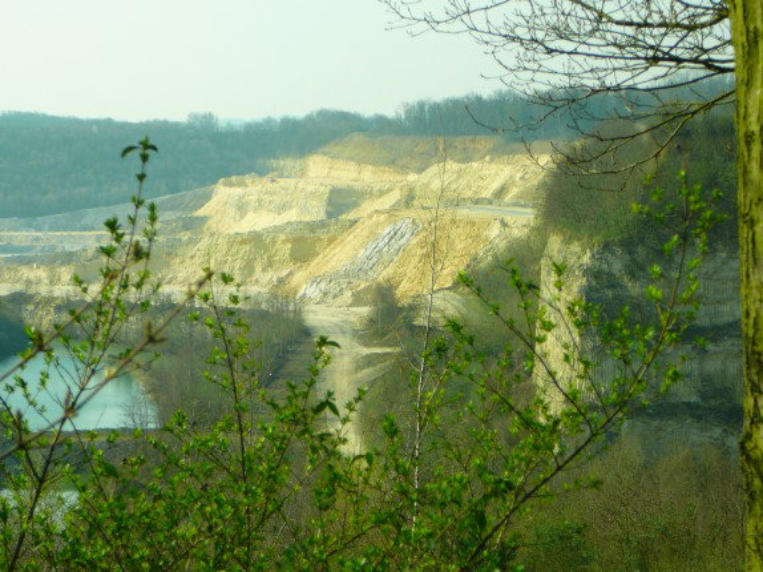
ENCI limestone quarry St. Peter’s mountain. Maastricht.
More about the ENCI cement factory and quarry in “Walk across the St. Pietersberg” under “City Walks”.

Charcoal drawing in
Grotten Noord.
(North Caves).

ENCI quarry 2016:
After 100 years of having extracted the
limestone /sandstone/ marl from the St. Peters
mountain, the ENCI cement factory will
definitely stop the extraction in 2018.
The quarry will be transformed into a tourist
attraction and natural area, with walking routes
and a swimming pond with a beach.
Maybe it is still possible to find fossils there.
Click HERE to read updates about the ENCI-
quarry.
In 2016 we visited the
Museum of National
History and there was
“Lars”,
ready to be freed
from the sandstone
(picture to the left).
You may follow the
progress in the
museum, from behind
a window.


In 2016 the first attraction was built: a
floating panoramic viewpoint over the
quarry.
In April 2017 the stairs into the quarry
were finished and the quarry was
officially opened to the public. There is
a walking route in the quarry.
Next project: the natural swimming
pond with a beach. In the quarry it is
always a few degrees warmer than
outside.
Address: Luikerstraat 80, Maastricht.




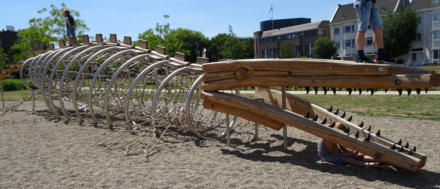
"Mosasaurus hoffmanni on loan to Maastricht"
De Nieuwe Ster, 11 February 2025, Maurice Ubachs
Translation by Ineke, edited by John
Alderman Frans Bastiaens surprised friend and foe on Tuesday evening. He hinted that
Bèr's ancestor, the Mosasaurus hoffmanni, may come to Maastricht in 2026 on "long-
term loan". The aim is to have the world-famous mosasaurus at home when the
renovated Natural History Museum in Maastricht reopens. According to Bastiaens, this
loan could last "a very long time".
The French themselves call the world-famous Mosasaurus from Maastricht that the revolutionary French
army brought to Paris 230 years ago a “trophée de guerre”; spoils of war. The skull is now on display in the
“Muséum national d'Histoire naturelle' in Paris”.
Relationship
Bastiaens is lobbying hard behind the scenes to bring the mosasaur back to Maastricht. The Hague did not
want to put pressure on the diplomatic relationship with France because of the skull. Bastiaens: "We had to
contact the French embassy ourselves."
Plenty of conversations
The alderman said on Tuesday evening that there are plenty of talks. "There is also a lot of app-contact.
We have to go to Paris quickly. The French now want to be sure that we will not keep the skull here
permanently. They are concerned about that, because the skull has already been here once and it was
suggested that “the skull should not be returned”. By the way, that happened in 2009.
Track
"The track we are on now," Bastiaens said, "is that we receive the mosasaur on long-term loan. And that
could be a very long time."
Last year, Bastiaens already indicated the importance of bringing back the mosasaur. "The Natural History
Museum of Maastricht needs this skull of the Mosasaurus more than ever. It has been 230 years since it
was brought to Paris. This year it marks the 175th anniversary of linking the Maastrichtian as a geological
time phase to the discovery of the Mosasaurus."
Skull
The skull of the Mosasaurus is a globally recognized icon that is linked to the city of Maastricht in name and
location. The skull also marks the start of the evolutionary Enlightenment thinking (in the spirit of Darwin)
and as such is of great historical importance. For that reason, people in Paris insisted on inclueding it in the
museum.
Icon
Bastiaens: "The Natural History Museum is a medium-sized museum that is facing a crucial renewal task
and with this icon would gain a lot of social support and an international reputation with this icon. Which is
of great importance in these times."
Impoverishment
In a letter to the council, the alderman previously took a small advance on a moral appeal to the French:
"We should arrive at a situation in which giving back is ultimately not seen as impoverishment (because
something one ”loses”) but as enrichment because injustice is recognized, a relationship is restored and
healing action is taken."
Ethical questions
As far as the alderman is concerned, the debate on restitution does not stop in the nineteenth century and
does not stop within Europe either. The appropriation of important iconic heritage objects under wartime
conditions is met with social resistance and raises more and more ethical questions.
Paris
Since 1794, the holotype (MNHNP AC 9648) – better known as the skull of the mosasaurus – has been in
the “Muséum national d’Histoire naturelle” in Paris. This skull was found in Maastricht in 1772 and in 1794,
according to the inscription next to the skull in the museum, it was taken to Paris by the revolutionary
French troops as a “trophy of war”. A cast of the skull from the Parisian museum can be admired in the
Natural History Museum Maastricht (De Bosquetplein 7).

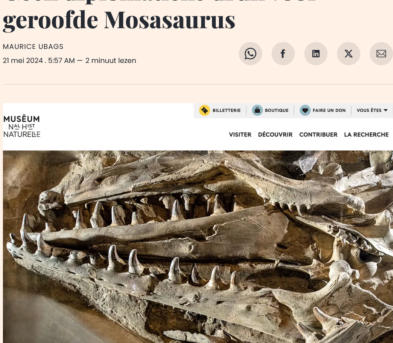
Photo left: No, I did not touch it!! Angela from Brazil, facing the skeleton
Fans who are in Maastricht for the André Rieu concerts will of course go sightseeing
Maastricht in between the concerts and visit the museums and other interesting places (see
the city walks and day trips, described on this website). We even found a playground for
children with a mosasaur as a play object!!



October 4, 2025, De Limburger, by Vikkie Bartholomeus
Photos: Harry Heuts (left), Rob Oostwegel (right)
Translation by Ineke, edited by Alice Leung
Paleontologist John Jagt investigates bloodthirsty squid and other sea monsters.
From gigantic mosasaurs to tiny mussel shrimp. The fossils from the Maastrichtian rock layer are
the life's work of paleontologist John Jagt. This geological period, just before the disappearance
of dinosaurs and mosasaurs, is named after Maastricht in scientific circles worldwide.
Earlier article in the Limburger:
August 18, 2024. The exhibition featuring the 3D-printed skeleton of the mosasaur Bèr opened in
Maastricht on Sunday to great interest. The Natural History Museum hopes this will help it find its way
back to the surface. Curator and paleontologist John Jagt was present in 1998 when the remains of this
mosasaur were discovered in the ENCI quarry. He nearly made it into the records himself as the
discoverer of the mosasaur, which is now on display as a complete 3D-printed skeleton at the Natural
History Museum in Maastricht.
John Jagt's office is a treasure trove, albeit a cluttered one. "Look, this is stuff we scraped off the knuckle
of mosasaur Carlo; it gives a glimpse of the flora and fauna from that time. The best part is that we even
found tiny droppings from spider crabs that had preyed on Carlo—seriously. You can give those droppings
a Latin name, and then you can see which carrion-snatching creatures they were. Almost no one knows
that."
This weekend, John Jagt will receive two prestigious Belgian awards.
Paleontologist John Jagt (64) of the Maastricht Natural History Museum will receive the André Dumont
Medal and the Palaeontologica Belgica Award this weekend in Brussels. These are two important awards
for his fossil research. For almost 35 years, he has been working on the museum's collection, which has
made a name for itself in the scientific community in recent decades. This is primarily due to the discovery
of four mosasaurs since 1998: Bèr, Lars, Carlo, and Kris. He is also credited with another leading
research from the Maastrichtian period.
Partially Professional
John Jagt dedicates his awards to the amateur paleontologists who have made the fossil collection so
rich. "Those citizen scientists are incredibly important. I sit here all day behind that stupid computer, but
they're the ones digging. They deliver. They're not just collectors; they're partial professionals with whom I
collaborate effectively. I can rely on them."
The Belgian appreciation for his work comes at a special time; his mother, Annie, recently passed away,
after whom he named an extinct sea lily (Actuatucametra Annea).
He chuckles. "I said at the cremation: whoever can repeat that Latin name will get a prize from me."
Several of his associates were present at her farewell. "Some are real friends, very close."
John Jagt became fascinated with fossils as a little boy. In primary school, he saw a film that zoomed in
on a boulevard in France. "I saw those bluestone tiles. It had rained, and you could just see the fossils in
them. Fantastic! My grandmother had an old threshold like that in the garden, and I went and hammered it
– bang, bang, bang – and there was a beautiful coral in it. That was number one in my collection."
Jagt originally started at the museum with the task of inventorying everything, but he soon realized this is
an impossible task. The collection continues to grow, despite the fact that a stop has been announced. Its
foundation is formed by nineteenth-century collectors like Casimir Ubaghs, Johannes Binkhorst van den
Binkhorst, and Joseph de Bosquet. However, many of their fossils were lost or dispersed because
Maastricht lacked a museum or university for a long time.
De Bosquet is John Jagt's "great hero"; his portrait hangs in his office as inspiration. From Maastricht, De
Bosquet corresponded with scientists like Darwin. Darwin was "astonished and delighted" when he
received a drawing by sea mail of a fossil less than 11 millimeters long. A white wart often found on
mussel shells.
The scientific value of the Maastricht collection is still too unknown, says John Jagt. "When you see what
still occasionally surfaces here, you think: how on earth can this be? Specialists sometimes get a fright:
did this come from Maastricht?" He is therefore pleased that the collaboration with Maastricht University
was established a few years ago. The museum will soon be renovated, and the outdated permanent
exhibition will be updated. A strong collaboration with Angola, where many mosasaurs from the
Maastrichtian period are found, is underway. In the science lab at the museum, they are prepared and
examined before they return to Angola.
The discovery of the four mosasaurs remains absolute highlights of his career. The 1990s, in particular,
were a golden age, when the cement industry in the Belgian and Dutch marl quarries (ENCI) was still in
full swing and excavators regularly cleared fresh hunting grounds for paleontologists.
“A mosasaur gives an indescribable feeling. Why isn't there a mosasaur hanging in the station hall?
Carnival balloons or Rieu banners hang all over the city, but you can't find the mosasaur. That's a missed
opportunity. We have to be content with a trellis-mosa on a children’s playground, they call it a climbing
Rex. Sorry, but we should be much prouder of the mosasaur.”
Not sacred
At the same time, he puts things into perspective. The sea monsters are not sacred. Mosasaurs are
always fun to find, but I also look at the other stuff. I'm talking about bloodthirsty squid, about spider crabs
whose huge claws could even pull a squid out of the water. The mosasaur represents 5 percent of
everything that lived here back then. The rest should be on display in the museum as well.
The most famous mosasaur from Maastricht, Mosasaurus hoffmanni, was brought to Paris by the French
in 1795 as a "crocodile head”. This is where the realization began that it might be an extinct species; you
could say the origins of the theory of evolution lie partly in Maastricht.
Spoils of War
Will it return to Maastricht? "All things considered, it's spoils of war," but how Paris views that remains to
be seen. "The museums in Berlin, London, and Warsaw are also full of type specimens from faraway
places. So, there's still a lot to come."


October 10, 2024
De Limburger, by Siebrand Vos
Photos by Harry Heuts
Translation by Ineke, edited by Alice Leung
Maastricht Natural History Museum to undergo major renovations, large garden near
the Jeker-river will become freely accessible
Maastricht will invest heavily in the renovation of the Natural History Museum, the housing of the
mosasaur Bèr, and the botanical garden. The collection of the only family museum needs to be
better presented.
The Natural History Museum's potential has not been fully utilized in recent years, the city council notes in
the accompanying council proposal: "The location, the monumental building, the beautiful (botanical)
garden, and the unique collection, which tells the story of the Cretaceous period, the mosasaur, and the
unique nature of the past and present, could all be better accessed and presented."
In recent years, departed staff members have not always been replaced, curator and paleontologist John
Jagt lamented in August 2024 at the opening of the Bèr exhibition. "We need to get the collections in
order and digitize millions of fossils. A monumental task."
Pride
The Natural History Museum can certainly contribute to pride and identity in Maastricht, suggest the
Mayor and Aldermen of Maastricht. Not only because of that mosasaur. But also because of the still-little-
known fact that the important geological period just before the disappearance of the dinosaurs and
mosasaurs was named after Maastricht, and is therefore known worldwide in scientific circles as the
Maastrichtian (at the end of the Cretaceous Period, around 70 million years ago).
The botanically interesting garden on the Jeker will be made freely accessible during the day to residents
and visitors to Maastricht's city center in the master plan. Furthermore, the entrance to the Museum must
be made more visible. The city council is asking for €5.3 million to start with for the implementation.


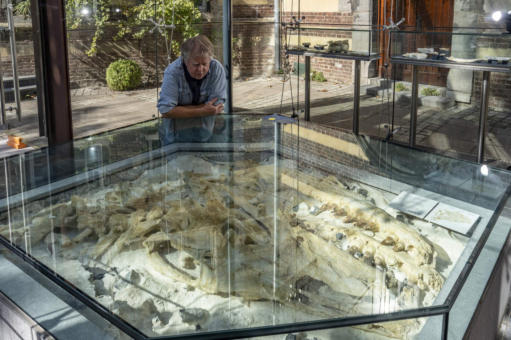
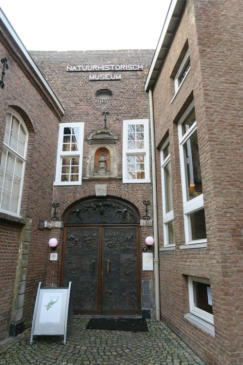

Botanical garden
Entrance of the Museum

- Maastricht Dinnertime
- Maastricht Preparations
- Tickets & accomodation
- Ticket Mediation
- Trains from Amsterdam Schiphol
- Trains from Brussels, Paris, Frankfurt and London
- Maastricht Fan Dinner
- Maastricht Fan Picnic
- Maastricht City Walks
- Maastricht Mosasaurus
- Daytrips from Maastricht
- Vrijthof news
- Maastricht Bonbonniere
- Maastricht ENCI quarry

- 2021 - 2025
- Previous items 2025 Jul - Dec
- Maastricht 2025
- Previous items 2025 Jan - Jun
- Previous items 2024 Jul - Dec
- Index of this period
- Doctor Peter de Beer
- Phil Bee
- Carlo Bonnie
- André’s Castle De Torentjes
- André gets his own stamp
- Typewriter artist
- Duo X-Elle
- Cinema experience 2024
- Quote Business Magazine
- Concerts in Bogotá, Colombia
- Margriet Magazine (1)
- Margriet Magazine (2)
- André Rieu turns 75
- André’s 75th birthday party
- Concert in Milano
- Roadsoap 5
- Presentation of second biography
- Het Financieele Dagblad
- 2024 Christmas concerts
- Interview with Marjorie
- Interview with André Rieu
- Interview from Nous Deux
- Dorona Alberti looks back
- Maastricht 2024
- Previous items 2024 Jan - Jun
- Index of this period
- Kimberly Smith
- Amsterdam New Year's concert
- MAX Magazine
- Stradivari instruments
- Golden Carriage
- Bahrain concert
- Ineke's book
- Emma's birthday in Greece
- Organic carrots
- Mexico Illness
- New animated series
- Trio SAAMN
- Andre Rieu in cinema 2024
- Sculpture of Andre Rieu
- Making of the bull
- Book 75 year Andre Rieu
- Previous items 2023 Jul - Dec
- Maastricht 2023
- Previous items 2023 Jan - Jun
- Previous items 2022 Jul - Dec
- Index of this period
- December with André
- Ivo on Sunday
- World Record Academy
- Privé / Telegraaf
- Two Vienna concerts
- Pierre Kartner (Father Abraham)
- Shellfish from ENCI quarry
- Zagreb concert
- Great Maastricht Dictation
- South America Tour
- Tribute to Queen Elizabeth II
- Rose Festival in Lottum
- Photo exhibition William Rutten
- Fake tickets on sale
- L1 interview
- Rieu and the Royals
- Interview with Pierre Rieu
- Efteling News
- Announcement Christmas concerts
- Boundlessly popular
- Maastricht 2022
- Previous items 2022 Jan - Jun
- Previous items 2021 Jul - Dec
- Index of this period
- LINDA's Winterguests
- Max Verstappen World champion F1
- Lisbon concerts
- Christmas cinema movie
- Koffietijd program
- Christmas concerts 2021 postponed
- Mindfuck
- ARD1, Club1 program
- Promoting Portugal tour
- Limburg Central article
- Andre's birthday
- Kingsday 2022 in Maastricht
- Podcast: weird hit wonder
- NDR talkshow
- 10 Christmas concerts in the MECC
- Vera Russwurm interview
- Flooding benefit program
- Humberto interview
- Flooding in Limburg
- Two best friends, Andre and Andre
- Previous items 2021 Jan - Jun
- Index of this period
- Maastrichts dialect
- Playing again!
- OP 1 Interview
- Vrijfhof 2021 concerts postponed
- Covid Vaccinations
- EVC Congress
- Julia and Kathy
- L1 Interview
- 3 AW Nights interview
- Dutch Bake-Off
- Chinese Interview
- Rijsemus Violin builder
- Al-Jazeera Interview
- Blaaskracht
- PRESS info
- Happy New Year
- 2015 - 2020
- Previous items 2020 Jul - Dec
- Previous items 2020 Jan - Jun
- Previous items 2019 Jul - Dec
- Maastricht 2019
- Previous items 2019 Jan - Jun
- Previous items 2018 Jul - Dec
- Maastricht 2018
- Previous items 2018 Jan - Jun
- Index of first half 2018
- June 26th, VNG Congress
- May 13th, Duckrace
- May 12th, Professor Scherder
- May 11th, Time for Max
- Bulgaria concerts
- Fake Rieus
- April 2018, Tel Aviv
- East USA Tour
- MDR Um 4, March 26th,2018
- May 9th, Sandy beach radio
- Universal Music Award
- Semper Opern Ball
- New Years Concert Amsterdam
- Previous items 2017 Jul - Dec
- Lift-Off Splash Percussian School
- Index of 2nd half 2017
- Carmen Nebel show
- Christmas Events 2017
- Interview with Frank Michael
- Celebrity Radio interview
- UK Tour 2017
- USA Tour 2017
- German Tour 2017
- Q&A with fans on Facebook
- Sunday Night Interview
- Mexico Donation
- Day-Time in Maastricht
- RTL Helemaal het einde
- ARD Brisant
- NDR Tietjen and Bommes
- Making of Cinema video
- Maastricht 2017
- Previous items 2017 Jan - Jun
- Index of first half 2017
- Interview with Steven Wright BBC2
- Portrait of a Passion
- The "Real" Andre Rieu
- Welcome to my World 2
- Double interview Andre Rieu and Jo Cortenaedt
- Mirusia "From The Heart"
- Larura Engel "En Canto"
- Refugee brought Andre Rieu success
- Carla Maffioletti "A Dream"
- Venetian Carnival Revelers
- Golden Oldie from 1985
- Agnes Fizzano's shop
- Carnival speech Mayor of Maastricht
- Maastricht Pastry Route
- 2017 Valentines day
- Rieu plays in Semper Oper Dresden
- Linda Custers, Princess Carnaval
- New Years concert Ziggo Dome
- Ziggo Dome rehearsal
- Previous items 2016 Jul - Dec
- 2016 Jul - Dec, Index
- SBS6 Stars Surprise Show Dec 21st, 2016
- Liverpool december 2016
- Magic Maastricht 2016
- BBC Breakfast Today Show
- ARD Advent Show
- Two Million Likes
- CinemaLive Christmas
- SWR 4 German TV
- Strictly Come Dancing
- The meaning of life
- Leute Heute
- Dancing with the Stars
- In Conversation
- Free Mini Concert in Maastricht
- L1 Radio Interview
- Josti Band 50 years
- NDR Talk Show
- New Maastricht Salon orchestra
- Rieu in Cinema
- Maastricht 2016
- Previous items 2016 Jan - Jun
- Previous items 2015 Jul - Dec
- 2015 Jul - Dec, Index
- Rieu entertainment
- Dec. 2015, Bild Star Magazine part 4
- Dec. 2015, Bild Star Magazine part 3
- Dec. 2015, Bild Star Magazine part 2
- Dec. 2015, Bild Star Magazine part 1
- Nov. 17th, 2015, RTL Boulevard
- Nov. 12th, Shownieuws
- Nov. 16th, Loose Women
- Oct. 30th, Colectiv Club Fire, Bucharest
- Roman Holiday (3)
- Roman Holiday (2)
- Roman Holiday (1)
- Oct. 26th, Classic FM Q&A
- Oct. 23rd, MDR at 4 PM
- Oct. 10th, Jubilee Award
- Sep. 19th, 2015, Carmen Nebel
- Maastricht 2015
- Previous items 2015 Jan - Jun
- 2015 Jan - Jun, Index
- Code M, the movie
- Bucharest Concerts Part 1
- Bucharest Concerts Part 2
- A Latin Breeze
- Maestro without borders
- Copenhagen Concert
- Brazilian Fans
- George Harper In Memoriam
- Press Conference Romania Open Air Concerts
- RTL Late Night Show
- AvroTros TV Show
- Cologne Concert
- Valentine's day
- Tempeleers Carnaval Medal
- Markus Lanz Talk Show
- 2007 - 2014
- Previous items 2014 Jan - Jun
- Maastricht 2014
- Maastricht 2014, The Preparations
- Maastricht 2014, (Dress) Rehearsal
- Maastricht 2014, The Concerts
- Maastricht 2014, Fan Dinner
- Maastricht 2014, Three Fan Picnics
- Maastricht 2014, Lift-Off
- Maastricht 2014, Exhibition Marc Rieu
- Maastricht 2014, Our Story Page 1
- Maastricht 2014, Our Story Page 2
- Maastricht 2014, Venetian Carnival, the making of
- Previous items 2014 Jul - Dec
- Previous items 2013 Jul - Dec
- Advent Calendar 2013
- Spirit of Christmas
- Nelson Mandela
- Movie Marina
- BBC Breakfast Show
- German TV programs (1)
- German TV programs (2)
- L1 Late November 5th, 2013
- RTL Boulevard, October 31st, 2013
- Amira Willighagen
- Evenblij with....
- Australian tour 2013
- German TV Sept.2013
- ORF Vera Russwurm
- Jean-Philippe composes ode to Mary
- Tietjen and Hirschhausen 2013
- Rieu to play on North Pole?
- Maastricht 2013
- Previous items 2013 Jan - Jun
- RTL Boulevard June 19th, 2013
- Jean-Philippe's children's books
- What I know about women
- AR-Academy
- Copenhagen concert
- SkyArts2
- Limbourgeois April 30th
- The making of the Coronation concert
- King's inauguration Day 2
- King's inauguration Day 1
- King's Waltz
- Charity TV broadcast
- classicFM interview
- Trini Lopez
- Jean-Philippe's book
- Jermaine Jackson
- Dutch Queen Abdicates
- history fan websites
- Cologne, Jan.1st 2013
- Previous items 2012 Jul - Dec
- Limbourgeois 25 December 2012
- Chistmas in Birmingham
- Linda Magazine, December 2012
- Advent calendar
- Cinema Heerlen 2012
- Boulevard Nov 21, 2012 and Ajax
- André's Birthhouse
- UK TV Programs November 2012
- Classic Brit Award
- Andre in Brazil 2012
- Interview Dolman Rieu
- BVN Trophy 2012
- Westland Fruit and Flower parade
- L1mbourgeois August 19, 2012
- Maastricht concert 2012
- Previous items 2012 Jan - Jun
- Previous items 2011 Jul - Dec
- Maastricht 2011
- Previous items 2011 Jan - Jun
- The person behind the phenomenon
- Andre and Hopkins
- Interview in Vienna
- Frank Steijns and "Normaal" band
- PBS visiting Maastricht 2006
- Amsterdam ArenA 2011
- Pierres Hobby
- DWDD May 26th, 2011
- Madiwodovrijdag show
- André Rieu and Anthony Hopkins
- Mirusia DVD release
- Scary moments in South Africa
- BUMA Export award 2010
- Interview with Mirusia
- WDR swap reporter
- Previous items 2010 Jul - Dec
- Platin Tenors at the Cologne Christmas market
- Koffietijd December 20th, 2010
- Christmas concert by Mirusia
- Today Show December 18th, 2010
- Ice Sculpture Maastricht 2010
- The André Rieu Story
- UK November 2010 appearances
- Mexico City, November 28th, 2010
- Ivo Niehe interviews André Rieu after his illness
- André is Back!!
- LeuteHeute 151110
- André is rehearsing again
- First interview after sickness
- André cancels UK and Aussie 2010 tour
- Jubilee book 30 years André Rieu
- Interview with Pierre about André's ilness.
- Three hours marathon interview
- André escapes Toronto
- Previous items 2010 Jan - Jun
- Maastricht 2010
- Maastricht Winery, South Africa
- The best of Thirty Years André Rieu
- Mainau 2010, "Roses from the South"
- Dancing on Ice, 2010 UK finals
- Maastricht Stampsheet
- André to play for Queen Beatrix of The Netherlands
- At home with Bela Mavrak
- Export award 2009
- Farewell mayor Leers
- Flikken Maastricht
- Cologne 2010 concert
- Previous items 2009
- André and Friends ArenA 2009
- André's 2009 Christmas interview
- Christmas with Carmen Nebel
- Frank Steijns carillon
- Dutchman of the Year 2009
- Royal Variety Performance
- Brisant
- Dreams come true
- André's twins
- MDR André 60th birthday interview
- Sydney Oct.2009
- Ivo Niehe's interview with Mirusia Louwerse
- Maastricht Liberators
- Heidelberg September 2009
- Maastricht 2009, the concert
- Maastricht 2009 update
- America Tour 2009
- The week of André Rieu
- André in Villa VANTHILT
- Boulevard and Knevel and van den Brink
- André Rieu about New York
- Carmen Nebel in Maastricht
- André named best selling male artist
- André Rieu Stamp Booklet
- Maastricht 2009
- Interview with André on RTL9
- Marc Rieu, the other son
- Andre Rieu on his way to Australia
- André and Vegemite
- Ruud and Ineke meet Kathi (Caramia)
- Road Soap review
- André in de ArenA
- André get awards
- Good afternoon Limburg
- van der Vorst ziet sterren
- Previous items 2008
- Australian interviews with André
- Holiday in Australia
- Ivo Melbourne
- From Maastricht to Melbourne
- Interviews December 2008
- Melbourne Concert 2008
- Trier 2004
- Dresden
- Kerner and Nebel
- Maastricht but different
- Maastricht Vrijthof concert 2008, the highlights
- 60 Minutes, André Rieu and Andrea Bocelli
- Maastricht 2008 concert
- Aussie Interviews
- André in Ottawa
- Andre Rieu Tulips in Ineke's garden
- Ovation-Schofield
- De Rode Loper
- Boulevard
- Riverboat
- The Last Show
- Benny Neyman
- Ivo Niehe March 2008
- Kruispunt
- Tietjen and Dibaba
- Toronto by Alice Leung
- Toronto 2007
- Cologne 2008 concert
- Previous items 2007

- Agnes Fizzano-Walter
- Anna Majchrzak
- Anna Reker
- Annabelle Traves
- Béla Mavrák
- Bibi Ortjens
- Boris Goldenblank
- Brass section
- Carla Maffioletti
- Carmen Monarcha
- Christina Petrou
- Cord Meyer Leusink
- Donij van Doorn
- Els Mercken
- Emma Kok
- Frank Steijns
- Gary Bennett
- Gosia Tarnowski
- Gracenotes
- Jean Sassen
- Joline Soomers
- Justinas Kaunas
- Kimmy Skota
- Kremi Minerva
- Laura Engel
- Lift-Off (Marcel Falize)
- Marcel Falize (1)
- Maja Jasinska
- Maastricht Salon Orchestra
- Manoe Konings
- Michaela Oeste
- Michel Tirabosco
- Mirusia Louwerse
- Night of the Proms
- Pierre Rieu
- Platin Tenors
- Rene Henket family
- Roger Diederen
- Ruud Merx / Lin Jong
- SAAMN trio
- Sanne Mestrom
- Serena Vanheuverswijn
- Stéphanie Detry
- Suzan Erens
- Tanja Derwahl
- Tiroler ohne Berge (Marcel Falize)
- VerrasSing
- Vincenzo Viola

- 2000 - 2009
- 2009: Andre meets Mr. Wijdbeens
- 2006: Josti Band
- 2006: Profiel
- 2005: Art Express Classic
- 2005: Interview with Catherine Keyl
- 2004: Portrait of a Passion
- 2004: André van Duin meets André Rieu
- 2004: Trier concert
- 2004: Rehearsal for Tros 40 year song
- 2003: Barbara Wussow
- 2002: TROS Cruise
- 2002: Barend en van Dorp
- 2001: José Carrera Gala
- 2001: The Ländler
- 2001: Open House
- 2000: BZN meets André Rieu
- 2000: A Dream Come True
- 1989 - 1999
- 1999: Andre @ Spanish RTVE
- 1999: Laat de Leeuw
- 1999: Alfredissimo
- 1998: Lesley Garrett
- 1998: Celebrities
- 1998 Early JSO
- 1997: Strauss Party - Kiel
- 1997/98 Bill's oldies 2
- 1997/98 Bill's oldies 1
- 1997: Im Krapfenwald
- 1996: Snow White, a fairytale
- 1996: André Rieu "In Concert"
- 1996: Charity Concert
- 1995 André and André
- 1995: Wiener Melange - Lübeck
- 1995: Karel van der Graaf
- 1995: Musikantenstadl
- 1995: TROS Op nieuwe toeren
- 1995: Carré Theatre (The Vienna I love)
- 1995: Veleta
- 1995: TVcommercial/A.van Duin
- 1995: First videoclip
- 1995: Angela's Challenge
- 1994: Schutterij EMM Ooy
- 1994: Strauss & Co
- 1994: Olympic Stadium
- 1992: Before he got famous
- 1989: Tineke's TV years
- Tour Programs 1987/88
- Tour Programs 1994/95
- 1985














